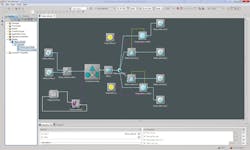Along with technical modifications such as frequency-controlled pumps, there are other ways for drinking water utilities to reduce energy costs. Operating high-consumption facilities according to power prices takes advantage of low prices in energy exchange markets. Studies by German consultancy ProCom indicate that significant pumping power cost reductions can be achieved in this way, in some cases as much as 25%. Cost-optimized operation requires sufficiently large water storage (water towers), which can be used to decouple water treatment and supply. The water utility also should be able to purchase its power from the electricity market directly or via a market-approved service provider.
Taking Advantage of Low Prices
The principle of power-optimized pump and storage management relies on the large volume of the water containers, which can be filled when power prices are low. Filling is avoided whenever possible at times when electricity costs more. To maintain a secure supply, cost-optimized operation takes account of minimum filling levels, firefighting water reserves and other restrictions. Changes in usage behavior, such as seasonal, weather-related or vacation-based fluctuations, also are considered.
Complying with all of these conditions and determining the best possible moment to purchase electricity can be achieved using IT-supported planning. ProCom offers a planning solution specifically tailored to water utilities, based on the proven BoFiT IT platform. The system offers concrete recommendations for optimized operation that take into account minimum filling levels, network topology, technical parameters, load conditions and contracts, as well as energy market prices. No modifications of the technical facilities themselves are needed: The solution is purely IT based.
Phase 1: Modeling of the Network & Load
Determining whether it is worth investing in a planning solution can be executed in advance at relatively low cost. The network topology, individual storage containers’ technical data, pumps or pump groups’ characteristic operating curves and other data are modeled. Delivery requirements also are entered into the detailed model, as well as economic boundary conditions and electricity purchase contracts or markets.
Calculations are based on historical water consumption data (such as hourly values from the previous year). The model can then simulate the filling and unfilling of the storage volumes.
Phase 2: Compare & Assess Scenarios
One scenario simulates the actual fill-oriented operation strategy with a fixed electricity price. The result indicates power costs similar to those actually incurred during the time frame being examined.
A second scenario simulates operation according to prices. Again, historical data are used, but the simulated operation now is optimized based on historical forecasts for electricity prices. This introduces the same uncertainty into the calculation as price predictions would have produced in real operation. Cost savings of some 5% to 10% usually are achieved compared with the first scenario.
The level of savings indicated by the calculation depends on storage capacity and pump performance. For lesser storage capacities, the savings will be smaller, while relatively generous storage leaves more flexibility to shift pumping times. In general, storage volumes should be able to buffer water consumption of about three to four hours to unfold a significant optimization potential. Such “free” storage capacity, not used for either daily operation or reserves, exists with many water utilities. These volumes are available for cost-optimized operation.
Phase 3: Integrate Power Generation Assets & Emergency Power Supplies
It may also be worth integrating emergency power supplies as possible power sources for “peak-shaving.” This can especially make sense in cases of power supply contracts coupled with power peaks. In this case, emergency power supplies are used to avoid peak loads and therefore notable costs. Multi-utility companies that provide electrical power can also integrate their drinking water facilities into their power generation portfolio. The flexibility of the high- response pumps then can be leveraged for the balancing energy market. In the best case, money can be earned when the pumps are running. Reduced pump operation costs and additional income from power generation in expansion turbines or from the balancing energy market create a potential to lower electricity costs by up to 25%, depending on network structure and consumption patterns.
Phase 4: Assess Portfolio & Portfolio Variants
Water utility operators also can use the model to assess their portfolio. For example, an operator deciding how to repair a container can compare a set of multiple scenarios to see whether maintaining a larger volume capacity or reducing volume is a better economic choice. Model variants with alternative pumps can be used to clearly quantify the economic benefits of frequency-controlled pumps compared with conventional facilities, and much more. In this way, users can check the cost-effectiveness of any investment.
Phase 5: Apply Cost Optimization in Day-to-Day Operation
The techno-economical model developed to analyze cost-saving potential also will be the basis for the operational optimization solution. It may be suitable to introduce the new operation mode only for parts of the system, so as to collect data from experience. Traditionally managed (fill level-based) facilities remain available as reserves during this transition period. This leaves operators the possibility of refining the model during the first few months risk free, before applying the recommendations developed by BoFiT to their entire network.
To prevent additional costs and burdens resulting from more complex planning processes, the BoFiT IT platform offers the possibility of automating processes company wide, building bridges between departments and IT systems.
Download: Here


